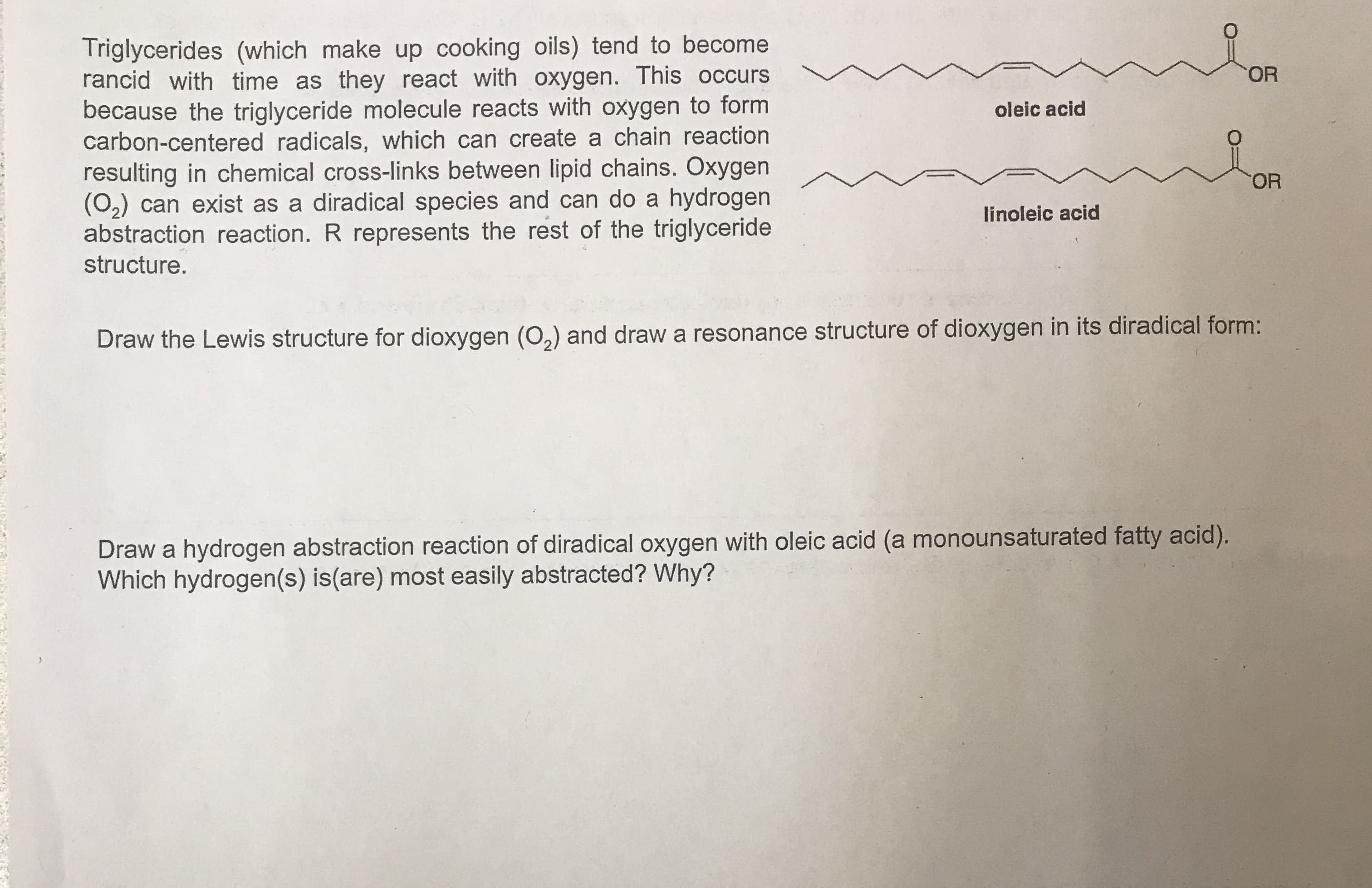Triglycerides (which make up cooking oils) tend to become rancid with time as they react with oxygen. This occurs because the triglyceride molecule reacts with oxygen to form carbon-centered radicals, which can create a chain reaction resulting in chemical cross-links between lipid chains. Oxygen (02) can exist as a diradical species and can do a hydrogen abstraction reaction. R represents the rest of the triglyceride OR oleic acid OR linoleic acid structure. Draw the Lewis structure for dioxygen (0,) and draw a resonance structure of dioxygen in its diradical form: Draw a hydrogen abstraction reaction of diradical oxygen with oleic acid (a monounsaturated fatty acid). Which hydrogen(s) is(are) most easily abstracted? Why?
Triglycerides (which make up cooking oils) tend to become rancid with time as they react with oxygen. This occurs because the triglyceride molecule reacts with oxygen to form carbon-centered radicals, which can create a chain reaction resulting in chemical cross-links between lipid chains. Oxygen (02) can exist as a diradical species and can do a hydrogen abstraction reaction. R represents the rest of the triglyceride OR oleic acid OR linoleic acid structure. Draw the Lewis structure for dioxygen (0,) and draw a resonance structure of dioxygen in its diradical form: Draw a hydrogen abstraction reaction of diradical oxygen with oleic acid (a monounsaturated fatty acid). Which hydrogen(s) is(are) most easily abstracted? Why?
Chemistry
10th Edition
ISBN:9781305957404
Author:Steven S. Zumdahl, Susan A. Zumdahl, Donald J. DeCoste
Publisher:Steven S. Zumdahl, Susan A. Zumdahl, Donald J. DeCoste
Chapter1: Chemical Foundations
Section: Chapter Questions
Problem 1RQ: Define and explain the differences between the following terms. a. law and theory b. theory and...
Related questions
Question
100%
I understand that the diradical dioxygen attacks a hydrogen on the carbon adjacent to the double bond but can I be shown the resonance mechanism and why we can't use a hydrogen directly from the double bond?

Transcribed Image Text:Triglycerides (which make up cooking oils) tend to become
rancid with time as they react with oxygen. This occurs
because the triglyceride molecule reacts with oxygen to form
carbon-centered radicals, which can create a chain reaction
resulting in chemical cross-links between lipid chains. Oxygen
(02) can exist as a diradical species and can do a hydrogen
abstraction reaction. R represents the rest of the triglyceride
OR
oleic acid
OR
linoleic acid
structure.
Draw the Lewis structure for dioxygen (0,) and draw a resonance structure of dioxygen in its diradical form:
Draw a hydrogen abstraction reaction of diradical oxygen with oleic acid (a monounsaturated fatty acid).
Which hydrogen(s) is(are) most easily abstracted? Why?
Expert Solution
This question has been solved!
Explore an expertly crafted, step-by-step solution for a thorough understanding of key concepts.
This is a popular solution!
Trending now
This is a popular solution!
Step by step
Solved in 2 steps with 2 images

Knowledge Booster
Learn more about
Need a deep-dive on the concept behind this application? Look no further. Learn more about this topic, chemistry and related others by exploring similar questions and additional content below.Recommended textbooks for you

Chemistry
Chemistry
ISBN:
9781305957404
Author:
Steven S. Zumdahl, Susan A. Zumdahl, Donald J. DeCoste
Publisher:
Cengage Learning

Chemistry
Chemistry
ISBN:
9781259911156
Author:
Raymond Chang Dr., Jason Overby Professor
Publisher:
McGraw-Hill Education

Principles of Instrumental Analysis
Chemistry
ISBN:
9781305577213
Author:
Douglas A. Skoog, F. James Holler, Stanley R. Crouch
Publisher:
Cengage Learning

Chemistry
Chemistry
ISBN:
9781305957404
Author:
Steven S. Zumdahl, Susan A. Zumdahl, Donald J. DeCoste
Publisher:
Cengage Learning

Chemistry
Chemistry
ISBN:
9781259911156
Author:
Raymond Chang Dr., Jason Overby Professor
Publisher:
McGraw-Hill Education

Principles of Instrumental Analysis
Chemistry
ISBN:
9781305577213
Author:
Douglas A. Skoog, F. James Holler, Stanley R. Crouch
Publisher:
Cengage Learning

Organic Chemistry
Chemistry
ISBN:
9780078021558
Author:
Janice Gorzynski Smith Dr.
Publisher:
McGraw-Hill Education

Chemistry: Principles and Reactions
Chemistry
ISBN:
9781305079373
Author:
William L. Masterton, Cecile N. Hurley
Publisher:
Cengage Learning

Elementary Principles of Chemical Processes, Bind…
Chemistry
ISBN:
9781118431221
Author:
Richard M. Felder, Ronald W. Rousseau, Lisa G. Bullard
Publisher:
WILEY